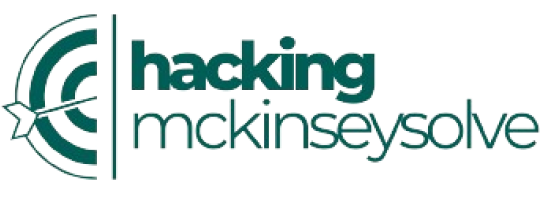The McKinsey Problem Solving Game, also known as the McKinsey Digital Assessment, has gained much attention since the company launched it to replace its more traditional business, pen-and-paper PST test. This test is a compulsory part of McKinsey’s recruiting process, so applicants often search for a glimpse of what to expect, mainly whether the test is a “pass or fail” kind of test.
Is it possible to bomb the McKinsey game?
The short answer is YES. With a cut-off rate of about 70–80%, the McKinsey Problem-Solving Game (PSG) is designed to identify the best talents from many applicants. You will get an email telling you whether you passed or failed after around two weeks of doing the test. No grades or comments are given; simply a plain pass/fail verdict.

What makes the McKinsey game challenging?
The McKinsey game is challenging for many applicants for two primary reasons: (i) the unusual test structure and (ii) an unpredictable assessment system.
Unusual test structure
The Problem Solving Game’s format—a fully-rendered video game placed in a natural, rather than business, environment—marks a dramatic shift from almost any other corporate selection approach. It takes between 60 and 81 minutes to complete the current version of the Imbellus, during which you play 2 games out of a potential of 6. The assessment is often divided into two or three scenarios or games, with two or three tasks required of you. The first scenario will usually take longer than the following ones.
The two minigames that come up the most often are “Ecosystem Building” and “Plant Defense.” On the other hand, “Disease Management,” “Disaster Management,” and “Migration Management” are seen far less frequently. The new 2022 addition, the “Redrock Study,” seems to have only appeared in Asia and the U.S. As long as both games are finished before the timer expires, candidates must decide on their strategy.
Unpredictable assessment system
While the games are separated into several sections, you are still only given one so much time, and you will not be forced to switch games if you wind up spending too much time on any game. To more accurately evaluate candidates’ thinking abilities—which are what McKinsey is mainly interested in—rather than candidates’ “processing speed,” Imbellus has explicitly stated that they have avoided including the aspect of time constraint in the Problem Solving Game.
Unlike other aptitude tests, giving a correct answer may not always show a candidate’s competence due to the possibility of lucky guessing or fluke. McKinsey games, on the other hand, monitor each keyboard and mouse movement to examine your approach to problem-solving. Given this and the absence of a severe time constraint, it is generally preferable to see the Problem Solving Game as something you should take your time with. It is a test of organized reasoning as opposed to fast thinking.

How can you fail the McKinsey game?
The odds of losing at the McKinsey game are increased by three primary factors: failure to complete the game’s goals, inadequate strategy, and worse performance than your competitors.
Unpredictable assessment system
Your product score (also known as the end outcome) is a key factor in determining how well you do in the McKinsey game and is earned by completing the following goals:
- Ecosystem Building: finding the ideal terrain for each species, sustaining a calorie surplus for all species, and constructing a continuous food chain.
- Plant Defense: protecting a plant for at least 15 game turns against a dangerous foreign invader.
- Disease Management: decide which animals on the map will get sick with an unknown illness by identifying its patterns.
- Disaster Management: identify the kind of natural catastrophe affecting an animal colony and relocate the animals to another point on the map to preserve the most animals.
- Migration Management: choose the optimal paths from a range of options to map the migration of 30–50 animals from a starting point to an endpoint.
- Redrock Study: review a business problem and address the aims and questions through data analysis and visualizing key findings.
It’s important to remember that: in addition to the product score, McKinsey will also consider your process score, which includes your movement and game plan.
Inadequate strategy
If you finished every objective in the McKinsey game and yet still failed, maybe your approach was incorrect. Candidates are evaluated based on their process score and product score. In order to determine if your method reflects that of a high-performing consultant at McKinsey, the system will technically track your behaviors throughout the whole problem-solving process—every keyboard, every click, and every mouse movement.

Here is a list of suggestions for strategies you may consider:
- Ecosystem Building: follow a planned procedure rather than randomly picking species. Remember to keep a structure in mind while using a top-down technique from the top predator or a bottom-up approach from suppliers.
- Plant Defense: see the larger picture; in other words, strive to prepare for long-term and future invaders rather than focusing solely on the present ones
- Disease Management: observe and keep track of the animals through different points in time to see if there are any changes.
- Disaster Management: analyze the species’ characteristics to find their most common traits. Use that finding to pick an optimal location.
- Migration Management: use the information given to you to pick the route that will provide you with the most animals and resources.
- Redrock Study: follow the 3-step process of (i) investigate; (ii) analyze; (iii) report. Keep in mind the skills that are used in case interviews.
Worse performance than your competitors
Even when you are comfortable with your game strategy and overall performance, it’s not for sure. There’s always the possibility that your fellow test-takers performed just slightly better than you. In reality, the pass percentage is just 20–30%, which is lower than the 30–35% of PST since test-takers from different jobs also take the test. As a result, the percentage of people in a given department who pass the McKinsey game decreases dramatically.
All of this is just to say that preparation is the key to successfully confronting the McKinsey PSG. There is no avoiding it because the minigames need you to quickly grasp vast knowledge, rules, and patterns and call for subtle methods in the gameplay.
